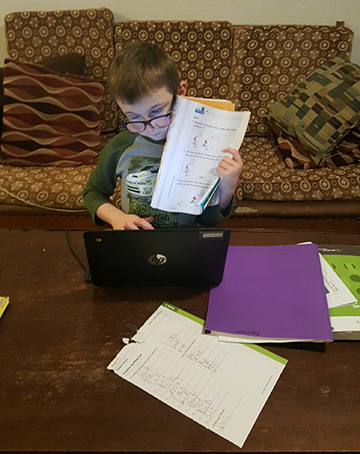
HARRISVILLE — Toni Scott and her son not long ago went a whole year without the internet at her rural home near Harrisville.
She’d tried internet access through a satellite company, but “it was super sketchy,” Scott, 45, said. “It was in and out all the time, and it just wasn’t worth the high cost I was paying.”
None of her limited options provided anything more reliable or affordable, so she just went without. Neither she nor her son are big Web people, anyway, so they made do. She worked in Alpena at the time and logged on to her work’s WiFi if she needed to.
In a pinch, she’d park at schools or libraries to access their internet from the parking lot.
“We were pretty resourceful,” she said.
But that was before COVID-19.
Before shutdowns designed to slow the spread of the coronavirus meant she had to work from home, her 6-year-old son had to learn from home, and streaming movies at home was about all there was for entertainment.
Then it became clear the Scotts were among the nearly a third of Northeast Michiganders without access to reliable internet or the minimum internet speeds the federal government says are necessary for modern life.
While most Michiganders can count on enough bandwidth pumped directly into their homes’ wiring to do all the livestreaming, shopping, emailing, and Netflix binge-watching they need, a sizable portion of residents in rural Northeast Michigan have to get creative to access the 21st century economy.
‘HAVE TO PROBLEM-SOLVE THAT’
Far north of the Scotts, Nicolle Wieschowski, 33, and her three children access the Web at their Presque Isle home through Wieschowski’s smartphone data plan.
Wieschowski is a teacher in Alpena Public Schools, where students have learned entirely online for weeks after coronavirus infections surged in November. When her kids — ages 12, 8, and 6 — are home with her, that data plan has to service 12 Google Meets sessions a day.
She pays for an unlimited data plan on her phone, but it’s really “unlimited” in name only. After a certain amount of data is used up, speeds slow down.
The Wieschowskis hit that threshold late last month, with several days to go before her billing cycle restarted and the data refilled.
But the phone did the job.
The phone plan “always worked for me,” Wieschowski said. Not just for work and her kids’ school, but for streaming Netflix and other diversions. “It’s always been enough to satisfy our needs.”
When the coronavirus roared again and students were sent home to learn, Wieschowski looked into buying a separate hotspot — a small device that, like her phone, uses cell signals to broadcast wireless internet connections. But she didn’t want to pay for a whole extra plan and her neighbors said on social media the service was spotty, anyway.
She considered connecting her home to the lone internet service provider in her area, but it would cost an extra $50 a month, with a long-term contract required. Unsure how long she’d need that service — how long the virus would keep her and her kids at home — she didn’t want to invest.
So her phone plan does its job, especially since her cell provider expanded her data at no cost because she’s a teacher.
There are hiccups. The phone she uses to connect her home to the Web is the same phone she uses to communicate all day long.
“When I leave, the internet goes with me,” Wieschowski said. “If somebody needs the internet when I’m not present, we do have to problem-solve that, but we’re usually able to figure that out. We have a pretty good support system.”
‘IT’S SUCH A CHALLENGE’
Read More at The Alpena News.





